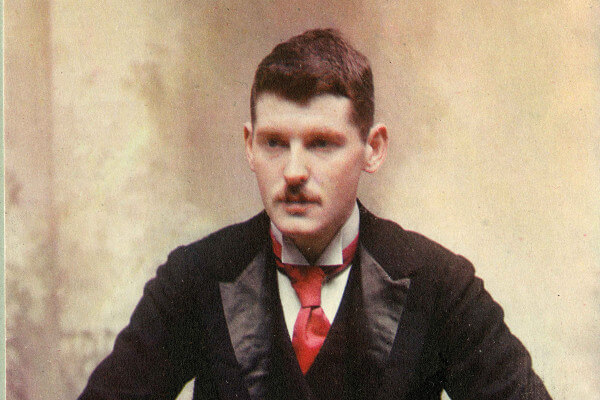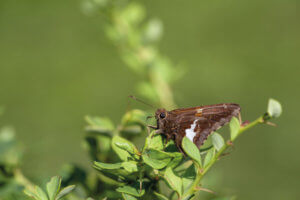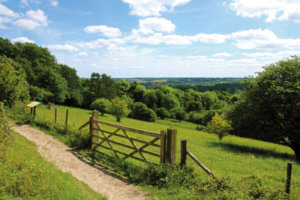Charles Rothschild – the Forgotten Younger Brother?

Walter Rothschild is famous for driving a carriage drawn by zebras and of course his collection that formed the basis of Tring’s Natural History Museum, but his younger brother left a lasting legacy that should not be forgotten…
He may not be quite as well known as his more flamboyant older brother but Charles Rothschild still left a lasting legacy, both around Tring and across the British Isles.
Nathaniel ‘Charles’ Rothschild was born in Tring in 1877. He spent much of his childhood at Tring Park, and was educated at Harrow and Trinity College Cambridge. He joined the family bank, but like his brother Walter he was fascinated by the natural world.
 Much of his focus was on entomology (the study of insects and their relationship to humans) and his collection of around 260,000 fleas is now in the Rothschild Collection at the Natural History Museum. He identified around 500 new flea species, including the plague vector flea, Xenopsylla cheopis. However, more importantly, he is considered a pioneer of nature conservation. He founded the first nature reserve in the UK at Wicken Fen (his father gave him an estate near Oundle in 1899).
Much of his focus was on entomology (the study of insects and their relationship to humans) and his collection of around 260,000 fleas is now in the Rothschild Collection at the Natural History Museum. He identified around 500 new flea species, including the plague vector flea, Xenopsylla cheopis. However, more importantly, he is considered a pioneer of nature conservation. He founded the first nature reserve in the UK at Wicken Fen (his father gave him an estate near Oundle in 1899).
The turning point for British nature conservation came in May 1912, when Charles held a meeting at the Natural History Museum in London. At that meeting he presented an idea for a new organisation to save the best places for wildlife in the British Isles. That meeting led to the founding of the Society for the Promotion of Nature Reserves (the predecessor of The Wildlife Trusts). His aim was to identify and protect the most important wildlife sites, rather than just individual species, a vision that led to nature conservation as we know it today.
During the three years following that meeting Charles coordinated a national survey of wildlife sites that were ‘worthy of preservation’ in Britain and Ireland. From that he produced The Rothschild List, which named the 284 best wildlife sites in the country, some of which were purchased as nature reserves. His daughter, Miriam, a gifted scientist later played a significant part within the Society too. It’s just a shame that Charles died in 1923 and so never saw the culmination of his work – the National Parks and Access to the Countryside Act 1949, which makes provision for National Parks and the establishment of a National Parks Commission; to confer on the Nature Conservancy and local authorities powers for the establishment and maintenance of nature reserves.
 One of the sites named on that list is Aldbury Nowers. This chalk hill is in the Chilterns and noted by Rothschild for its ‘rare plants and insects’ – in particular the silver-spotted skipper butterfly, the pasqueflower and field fleawort. The site suffered some neglect and lack of management but is now managed by the Herts & Middlesex Wildlife Trust, and its recovery is in progress. Following some chalk grassland restoration work, the small blue butterfly has recently returned to the reserve, and it’s a wonderful place to see wildflowers, butterflies and many other chalk grassland species.
One of the sites named on that list is Aldbury Nowers. This chalk hill is in the Chilterns and noted by Rothschild for its ‘rare plants and insects’ – in particular the silver-spotted skipper butterfly, the pasqueflower and field fleawort. The site suffered some neglect and lack of management but is now managed by the Herts & Middlesex Wildlife Trust, and its recovery is in progress. Following some chalk grassland restoration work, the small blue butterfly has recently returned to the reserve, and it’s a wonderful place to see wildflowers, butterflies and many other chalk grassland species.
Other sites nearby named on the list include Coombe Hill near Wendover.
Dancersend, near Aston Clinton, was once owned by the Rothschild family, and though not named on the list, was designated as a nature reserve in the 1940s in remembrance of Charles. It is now run by the Berks, Bucks and Oxon Wildlife Trust.
Charles inherited the Tring park estate during World War 1 (although it was his elder brother who inherited the title of Lord.). Tim Amsden, Tring Local History Museum, tells Living: ‘Charles co-operated with Hertfordshire County Council in the implementation of the 1919 Land Settlement (Facilities) Act by putting forward Dunsley Farm, which has been run as a County farm tenancy ever since. Some of its land in Cow Lane was split off as smallholdings. On one of these a bungalow was built for a Mr Jeacock – it’s now a listed building. Also built was Cow Lane Farm. All of this land is now threatened by housing development.
‘The Urban District Council (UDC), which wanted to broaden its rates income base, asked for the frontage to Station Road to be reserved for ‘better class housing’ and this resulted in the row of substantial houses running from the Cricket Club to Cow Lane.
‘The 1919 Housing Act (‘Homes Fit for Heroes’) required local councils to build houses, and Charles gave the UDC enough land off Dundale Road to build 50 houses. In the event they could only muster the finances to build 12 (which are the ones continuing from those his father had built for the Council in 1913). The Estate insisted that the remaining land must not be sold off, but must be given away to anyone who was able to build themselves a house on it. The result was Manor Road.
‘It’s worth bearing in mind that Charles was a very sick man during this time, and most of his affairs in Tring were being conducted by his wife Rózsika and his agent Richardson Carr.’
With thanks to Tim Amsden, Tring Local History Museum, and author of The Rothschilds and Tring, and Herts & Middlesex Wildlife Trust.

